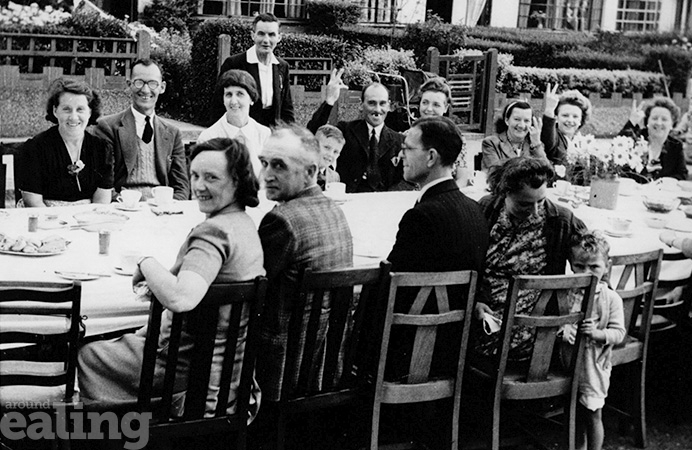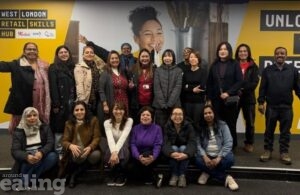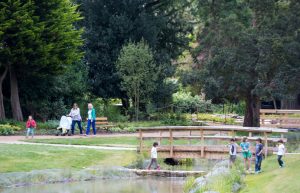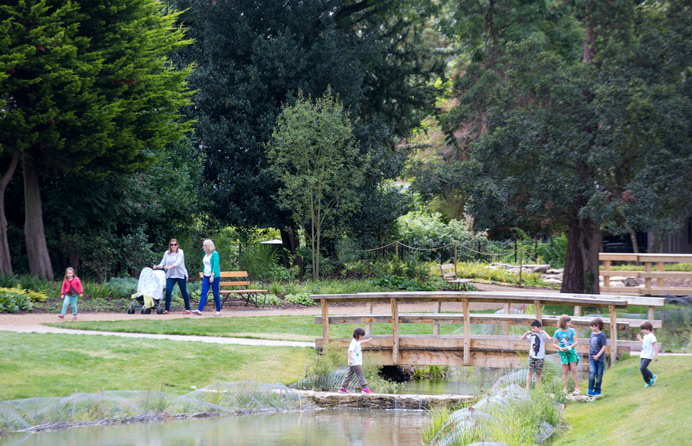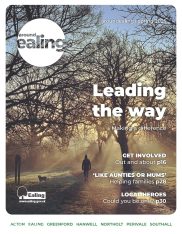When the original VE Day (Victory in Europe) was celebrated 80 years ago, Acton was, in many ways, a very different town from that of today. Borough archivist Dr Jonathan Oates looks at how it marked the big event.
In 1945, Acton was dominated by heavy industry in Acton Vale and by many laundries. In South Acton, there were rows of terraced houses, rather than the tower blocks that came to replace them post-war for many years.
At the beginning of May 1945, it was clear that the war in Europe could not last much longer, with the Allied armies closing in on the heartland of Germany and Hitler having killed himself. VE day was eagerly anticipated.
The town council of Acton and the local churches had already decided to hold a service and parade on the Sunday following the end of hostilities in Europe. The plan was to meet at Acton Park for a thanksgiving service and then to parade up the High Street and Acton Hill. Local organisations were to take part and the Salvation Army band would provide the music. They would begin at 3:15pm.
Celebration tinged with sadness and caution
It is worth recalling that many people approached VE Day with mixed feelings. As Harry Longhurst, MP for Action remarked, he felt gratitude to the servicemen who had fought in the war and especially to those who had been killed. A huge debt was owed to these men. He personally did not think there was a need to celebrate. This was because the war was not over; only part of it, because the Japanese enemy was still undefeated. Many families had loved ones who were still serving in the Far East.
Another commentator observed that ‘we would like a holiday’ but wondered ‘who would do the work?’ He wrote: ‘They would like to fly their flags but there is no rope. We would like all the lights to go on again, but we have to economise on fuel. Most of all we would like all our young men back again but that could not be so. However, it would be a relief to see prisoners of war returning from Germany and to travel in buses without the netting on the windows.’
The audiences at the Savoy cinema in east Acton were happy to see the message flash on the cinema screen: ‘The Germans have surrendered’. The organist immediately played God save the King and Land of Hope and Glory and the audience began dancing in the aisles. Unfortunately, it was too soon – the deputy manager came up to the stage and persuaded the organist to cease because there had been a technical problem and that the message on the screen had not had the end of the message which was ‘in Italy’.
Flags, dancing and singing everywhere
When VE Day was announced on Monday 7 May 1945, flags started to appear in the High Street that morning. Prams were seen with little union flags and, when the schools finished, children aged between 8 and 12 were seen ‘striding purposefully along with their larger flags’.
In the evening, ‘You could hardly go round a corner without meeting a man with a stepladder. There were ladders everywhere’. Shops were festooned with bunting and those on King Street had a ‘dignified row of the banners of the United Nations’. The dog at the Globe cinema wore a union flag bow tie. The town hall flew two union flags. Bunting also spread across the streets at Park Road North and Church Road.
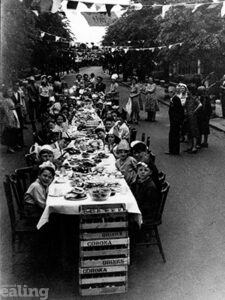
Unofficial bonfires were lit that evening in Acton. There was a blaze on Acton Vale that many children who had never yet experienced a bonfire night, were able to witness. This was at the allotments site and continued until way past midnight. Forms from the shelters, old mattresses, wood from Bromyard Avenue playing field and chestnut palings, were part of the fuel. Children ran home to find any bits of wood they could.
The actual, official VE Day was Tuesday 8 May. The day was sunny, following a heavy thunderstorm in the night-time. The High Street was busy with shoppers, buying food and drink for the next two days when the shops would be closed. There were many queues, as food was rationed.
At St Mary’s church, the bell ringers were busy. Unfortunately, the firemen who tried to hoist a flag on the church tower were unsuccessful. So, the flag was drooped over the battlements.
The pubs were also busy. From the middle of the day, the sound of singing could be heard by passers-by: ‘in the middle of the day you could walk along the High Street to hear waves if untuneful song, first from oner an then from another.’ A group of young people behind a man pretending to play a cornet, danced up the High Street.
After Churchill’s speech that evening, couples danced on the green outside the church and the singing continued. There were fires seen on almost every street in South Acton. With their glow in the night, and the noise of the fireworks, and the searchlight display, it was a little like the blitz, but less deadly.
Couples danced around each fire and sang to wireless music blaring from houses. Pianos were brought out into the street for more musical accompaniment, but one piano taken outside one pub was broken up to be used as bonfire firewood. Yet, in the middle of all this, two men could be seen by a window calmly playing a game of cribbage.
There were also services of thanksgiving in all the churches that evening and they were well attended. Congregations sang most heartily. There was more bell ringing by visiting ringers.
At Clovelly Road, the music was replayed by loudspeakers working from an amplifier as arranged by Fred Thomas from his front room. After Churchill’s and the King’s speeches, the party went on until 3am next morning. Around 200 people danced, and it continued next day as well with another large bonfire.
James Darbon was a child at the time and he later had the following recollection, writing: ‘From early morning in that day the area was a hive of activity in preparation for the celebration. An abandoned gypsy caravan been found in a local coach house and, as a base for the focal point of the festivities, had been wheeled to the junction of Park Road North and Osborne Road. On the roof were Guys representing the three Axis powers: Adolf Hitler (Germany), Benito Mussolini (Italy) and Prime Minister (Japan). The day was spent filling the inside with combustible material and more was thrown on the outside.
‘When darkness fell a large crowd witnessed the lighting of the fire. There were no fireworks available: the making of explosives had been for other purposes. The biggest cheer of the evening came when a local woman symbolically threw her black out curtains into the flames. Late into the night it was agreed that it was the best bonfire there had ever been’.
Time for street parties
On the next day, Wednesday 9 May, it was the time for the street parties. These were nothing new to adults and older children because there had been many in Acton in the 1935 to celebrate the Silver Jubilee of George V and the coronation of his son in 1937. These were often in working class areas were people often worked in the same place and knew each other to an extent that later became less common.
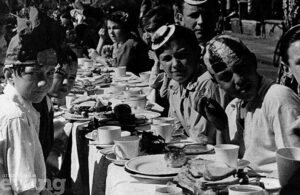
These seem to have been held in many Action streets and there were newspaper reports of many of them. Often several streets clubbed together so for example over a hundred children from Allison Road, Brougham Road, Birkbeck and Faraday Road, had a combined event. Mr and Mrs Elliott of 18 Allison Road organised it and over £14 was collected to pay for the food and drink. Gifts in kind were also given, with neighbours contributing tea, sugar and milk, which was a sacrifice because these were all rationed.
Before the tea there were various games. Prizes were awarded for the winners. There was even a race for the parents. Tables and chairs from the houses in the street were brought out into the road. Crockery was provided by local people, too. One small child brought out a white mug with his name and address on it in case it got lost. Many of the fathers also took as much a part as the children’ presumably the women were focused on preparing and serving the food and drinks.
Some parties were held in gardens. Mrs Harker held a children’s party at 11 Lowfield Road in her back garden. She and other mothers had decided on this on Monday and, by Wednesday, they had made their own cakes, blancmanges of different colours, sandwiches and an almond fruit cake. On the cake icing was ‘Hurrah for VE Day’. Unfortunately, in the afternoon it began to rain and, although they tried to ignore it, eventually they all went inside and had various party games there instead.
Some parties were held later; at Seymour Road and Wolsely Road it was on the Sunday 13 May. The mayor and mayoress of Acton went to it after having been to the official celebrations, which 2,000 people took part in. The cake at this street party weighed 20 pounds and each child was given a slice and a rose. The cake had been made by Mr Kitton, a shopkeeper of 28 Cunnington Street. Again, the organisers of the event were all women. Children left with a mug, a 3-penny piece and a paper hat.
At Follot Street in east Acton, the party was on the Saturday. Flags were flying in the street and as time went on floodlights were used and the event became a party for the adults. It finished at 1:30am.
Hope and hard work
The Acton newspaper editorial repeated Churchill’s words: ‘When shall the reputation and faith of this generation of English men and women fall? I say that in the long years to come, not only to the people of this island, but from all over the world, where the bird of freedom chirps in human hearts they will look back to what we have done, and they will say, “Don’t despair, don’t yield to violence and tyranny’”.
Of course, it was realised that the problems of the post-war world would be difficult to deal with after the sound of the bells and the singing disappeared, the glow of the fires faded and the sight of the flags lost its fervour. It would not be easy to rebuild the world and the country but, looking back to 1940 after Dunkirk, the difficulties of that time had been overcome and were equally hard.
VE day was important because it meant the end of the fighting that had began in September 1939 and that a monstrous, murderous tyranny had been vanquished forever. Western Europe was no longer under the dangers of bombing. However, on the Home Front, rationing continued for years and in some way became worse.
Abroad, there was still the war in the Far East and that continued for another 3 months.
The dismantling of the war effort and the transition to a peace economy was also hard and a local example was that just after VE Day there was an announcement that, at Napiers, many workers, no longer need ed to make parts for military vehicles, would be made redundant.
However, peace and victory brought relief and hope, especially following VJ day in August 1945. The 6 years of war had resulted in many hardships, destruction and death. Peace has its problems, but war has more.
Dr Oates is due to give a talk on this subject at Michael Flanders Resource Centre in Acton on 8 May.
Read more VE Day local history
- Read Erica Ford’s full diaries from 1940 onwards, taking in VE and VJ days locally
- Read another story in our local history section about how the first VE Day was celebrated in 1945 locally
